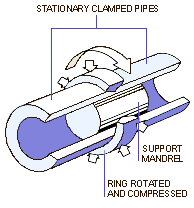Radial friction weldingby Peter Sketchley and Philip ThreadgillWhat is it?Radial friction welding (RFW) is a one shot forge welding process, initially developed at TWI, for pipe joining. Conventional rotary friction welding requires that one pipe length is rotated to generate frictional heating, but using RFW both pipes remain stationary. The technique involves rotation and radial compression of a solid bevelled ring into a V preparation provided by the pipe ends to be joined. To prevent collapse of the pipe ends and metal penetration into the bore, an internal support mandrel is provided at the weld location, as shown in Fig.1.
Alternatively metal bands can be welded around solid or tubular cylinders by rotating a solid ring and applying radial compression. Current statusFollowing initial development of the process and demonstration of its viability on modified equipment at TWI in the mid 1970's, a dedicated RFW machine was designed and built at TWI to join 50.8mm diameter x 6.5mm wall thickness pipes. During the 1980's, a Norwegian company, in co-operation with TWI, designed and built a prototype RFW machine for commercial pipe laying operations offshore, for 100mm diameter x 12.7mm wall thickness pipes. Further research work at TWI and commercial enterprises showed that the RFW process was suitable for joining corrosion resistant materials and titanium alloys. Currently, a major offshore services company is commissioning a machine capable of welding 6-12" (150-300 mm) diameter pipes in titanium alloy for risers. Additionally, military research organisations have extensively tested artillery shells which have the copper alloy driving bands attached by RFW, ranging in sizes from 20mm diameter up to 155mm diameter. Important current issuesAlthough the technology has been available for some twenty years, the RFW process has not been commercially exploited, in part due to the high cost of equipment. However, the joining of titanium alloy risers for the offshore industry is looking most promising. There is still great interest in using RFW for applying driving bands to artillery shells. The driving force behind this is the requirement of the shell body weight to be reduced, which will allow the payload carried to be increased proportionally. Typical banding materials tested to date are copper and its alloys, aluminium and soft iron. The development of affordable RFW equipment is required to enable the advantages of the process to be applied commercially. Benefits
RisksRFW has not been proven commercially to date, therefore development of
applications is required. The high cost of equipment is the main risk for
this un-commercialised process. |
|||
|
